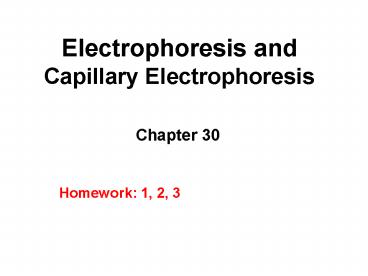Electrophoresis and - PowerPoint PPT Presentation
1 / 18
Title:
Electrophoresis and
Description:
Electrophoretic mobility (mep) is a constant and a intrinsic property. of an ion. It is dependant on the charge and 3-D ... Disadvantage: less selectivity ... – PowerPoint PPT presentation
Number of Views:267
Avg rating:3.0/5.0
Title: Electrophoresis and
1
Electrophoresis and Capillary Electrophoresis
Chapter 30
Homework 1, 2, 3
2
Electrophoresis
1. Capillary Electrophoresis
1. Capillary Electrophoresis
2. Gel Electrophoresis in Bio-applications
Science, Nov. 12, 2004
3
Modes of separation capillary electrophoresis
1. Capillary Zone electrophoresis
2.Capillary iso-electric focusing
3. Micellar electrokinetic Capillary
chromatography
4
Capillary Electrophoresis
- Introduction
- electrophoresis the migration of ions in
solution under the influence - of an electric flied.
-
-
f uep
q E
-
-
-
qE f uep
Accelerating force
Frictional force
b. Electrophoretic mobility
q
uep
uep E
q
mep E
f
mep
f
E
Electrophoretic mobility
5
Electrophoretic mobility (mep) is a constant and
a intrinsic property of an ion. It is dependant
on the charge and 3-D structure of the ion.
i. Molecules of similar size, the magnitude of
the mobility (mep ) increases with charge
ii. For a spherical particle of radius r moving
through a fluid of viscosity h, the friction
coefficient f is
Stokes equation f 6phr
q
mep
6phr
6
C. Capillary electrophoresis
Capillary electrophoresis is formed in fused SiO2
capillary tube long 0.5 m, inner diameter
25-75 mm.
7
Fused SiO2 Capillary Tube?
Fused silica capillary has exposed silanol groups
which have a pKa 2 which means that at pHs
above this there is a negative surface charge
(-SiO-)
Electroosmosis
8
Electroosmosis
When DC voltage is applied, the excess positive
charge ions (cations) migrate toward cathode.
This migration is called electroosmosis. The
resulted flow of bulk solvents is called
electroosmotic flow (EOF)
9
Electroosmotic flow (EOF)
Electroosmotic mobility is the constant of
proportionality between electroosmotic velocity
(ueo) and applied field E
ueo meo E
Electroosmotic mobility (is proportional to
surface
charge density on the silica)
This is one reason why capillary electrophoresis
has better separation efficiency.
10
Capillary Electrophoresis
Apparent Mobility
uapp
ueo
uep
11
Apparent Mobility of An Ion
Apparent Mobility (mapp)
mapp mep meo
unet
Ld/t
mapp
E
V/Lt
Ld is the length from the injector to the
detector Lt is the length from one end to
another V the voltage applied t is the time
required for solute to migrate from the injector
to the detector
Measurement of Electroosmotic mobility
unutral
Ld/tneutral
meo
E
V/Lt
12
Capillary Electrophoresis
- Separation Efficiency
- Recall
- No particles ? no multiple paths term (A 0)
- No stationary phase ? no resistance to mass
transfer term (C 0) - Increase velocity by increasing applied voltage,
but due to solution resistance this generates
heat and increases longitudinal diffusion (B)
13
Capillary Electrophoresis
2 D
2 D L
B
2 D
H
mappE
ux
ux
mappV
where D diffusion coefficient (m2/s)
- Plate number is independent of capillary length
at constant !
ii. The higher the voltage, the greater the
number of plates.
iii. The smaller the diffusion coefficient, the
greater the number of plates.
14
How many theoretical plates might we hope to
attain?
Using typical values ?app 2 x 10-8 m2/V?s which
corresponds to a 10 minute migration time in a 55
cm long capillary with 25 kV (Serum albumin (a
protein) with D 0.059 x 10-9 m2/s, and K with
D 2 x 10-9 m2/s).
mappV
N
2D
For K N 125, 000 plates, H L/N 4.4
mm For serum albumin N 4.2 x 106 plates
H L/N 0.13 mm
A greater plate number means a sharper peak!
15
Modes of separation capillary electrophoresis
1. Capillary Zone electrophoresis
2.Capillary iso-electric focusing
3. Micellar electrokinetic Capillary
chromatography
16
Capillary iso-electric focusing
pH
pH
iso-electric
zwitterionic
In this case, the electroosmotic force is weaker
than elctrophoretic force.
17
Micellar electrokinetic Capillary chromatography
Separation of neutral solute
Psuedo-stationary phase
18
The End!
Here is the end of the journey of this course,
but it is a beginning for the new future of all
of us. I thank you for taking this class. I
really enjoyed teaching this class and talking
with you. I wish all of you have a brilliant
future!































